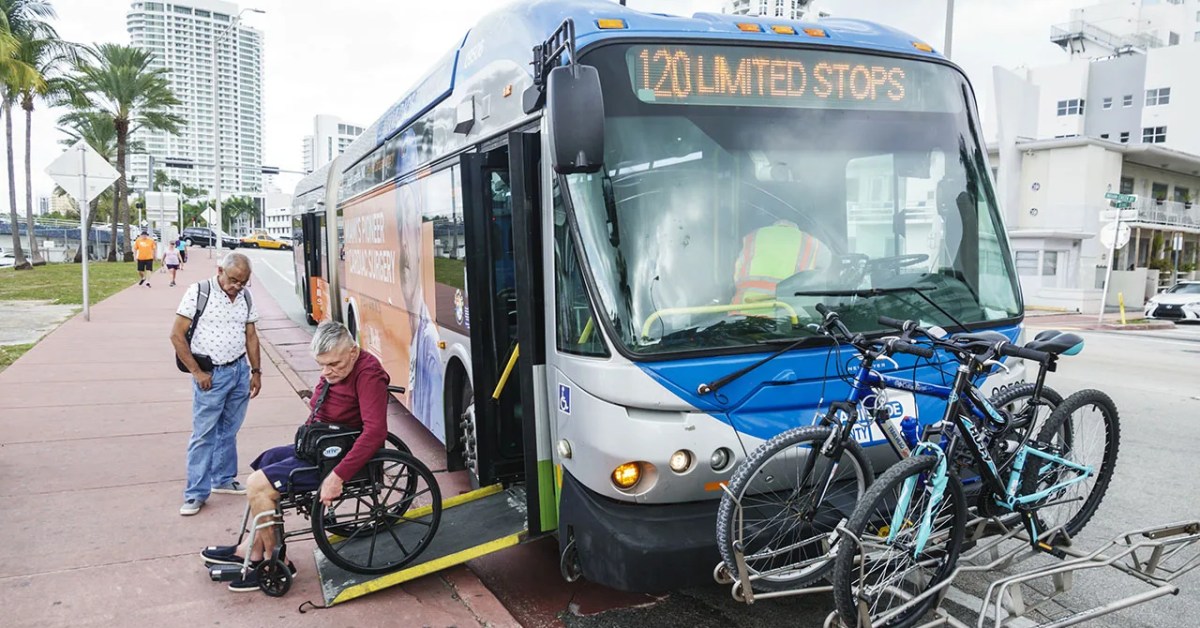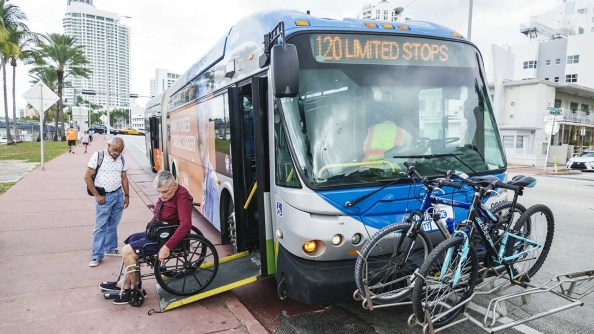 A bus passenger uses a handicap ramp in Miami Beach, Florida. (Jeffrey Greenberg/Education Images/Universal Images Group via Getty Images)
A bus passenger uses a handicap ramp in Miami Beach, Florida. (Jeffrey Greenberg/Education Images/Universal Images Group via Getty Images)
July is Disability Pride Month in the United States, commemorating the passage of the Americans with Disabilities Act over 30 years ago. Nationwide, there are approximately 42.5 million Americans with disabilities, making up 13% of the civilian non-institutional population, according to 2021 U.S. Census Bureau data. This group includes people with challenges with hearing, vision, cognition, mobility, self-care, or independent living.
Here are eight facts about Americans with disabilities, based on government data and a recent Pew Research Center survey.
Pew Research Center conducted this analysis to share key facts about Americans with disabilities during Disability Pride Month.
The analysis included data from the U.S. Census Bureau’s American Community Survey, which defines disability status by asking about six types of impairment: hearing, vision, cognition, serious difficulty walking or climbing stairs, and difficulty with self-care and independent living. Other surveys with different definitions estimate that significantly more Americans have a disability.
Occupational data by disability type were obtained from the Bureau of Labor Statistics.
Federal education data are obtained from the National Center for Education Statistics. For this analysis, students with disabilities include students ages 3 to 21 who are covered by the federal Individuals with Disabilities Education Act (IDEA). IDEA provides children with disabilities with access to a free appropriate public school education and guarantees special education and related services.
Hispanic Americans in this analysis are of any race. All other racial categories include people who identify only as a specific race, not Hispanic.
The polling results in this analysis are based on Pew Research Center surveys. More information about each survey question and methodology is available through links within the analysis.
Due to the nature of live telephone surveys, this analysis may underrepresent some Americans with disabilities. The numbers on technology adoption and internet use are from telephone surveys conducted on landlines and mobile phones, which may underrepresent adults with hearing or speech disabilities. Also, our survey does not cover people living in institutionalized congregate living settings, which may include individuals with severe disabilities.
Older Americans are significantly more likely to have a disability than younger adults: About 46% of Americans ages 75 and older and 24% of those ages 65 to 74 report having a disability, according to estimates from the Census Bureau’s 2021 American Community Survey (ACS), compared with 12% of adults ages 35 to 64 and 8% of adults under 35.
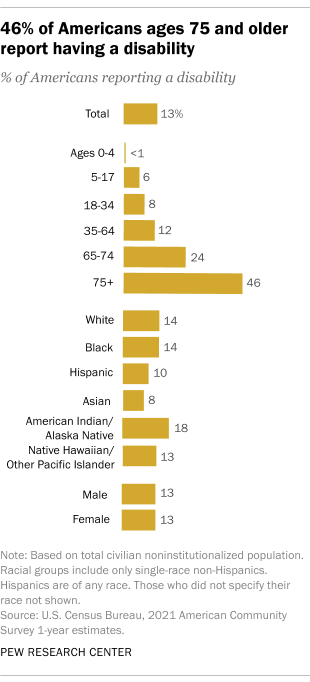
Americans of certain racial and ethnic groups are more likely to have a disability. According to 2021 ACS estimates, American Indians and Alaska Natives (18%) are more likely to report having a disability than Americans of other racial and ethnic backgrounds. Asian Americans and Hispanic Americans are the least likely to say they have a disability (8% and 10%, respectively). The percentages of White Americans and Black Americans who report living with a disability fall in the middle (14% each).
The most common types of disabilities in the United States are mobility, independent living, or cognitive difficulties. The ACS estimates that about 7% of Americans report having significant mobility difficulties, such as having trouble walking or climbing stairs. Adults age 75 and older and people ages 65-74 are most likely to report having this type of disability (30% and 15%, respectively). Much lower percentages of people ages 35-64 (6%) and 18-34 (1%) report having mobility problems.
About 6% of Americans report having difficulty living independently – struggling to get things done independently due to physical, mental, or emotional issues – and a similar percentage (5%) report having cognitive disabilities – trouble remembering, concentrating, or making decisions – all of which are more prevalent among older Americans than younger age groups.
Americans with disabilities tend to earn less than those without disabilities. According to the Census Bureau, the median income of people with disabilities in 2021 was $28,438, compared with $40,948 for people without disabilities. (These figures represent income for employed, noninstitutionalized Americans age 16 and older, and reflect income for the past 12 months in 2021 inflation-adjusted dollars.)
According to the Bureau of Labor Statistics (BLS), people with disabilities made up an average of 4% of employed Americans in 2022. People with disabilities were most likely to work in management occupations (12%) and clerical/administrative support occupations (11%), according to annual averages compiled by the BLS, which tracks 22 occupations. Meanwhile, on average, about 10% of workers in transportation and material handling occupations were disabled in 2022.
Americans with disabilities have lower technology adoption rates across some devices. A Winter 2021 Center survey found that U.S. adults with disabilities are less likely than those without disabilities to say they own a desktop or laptop computer (62% vs. 81%) or a smartphone (72% vs. 88%). The survey asked respondents whether “any disability, handicap, or chronic illness prevents you from fully participating in work, school, household chores, or other activities.” (It should be noted that polls vary widely in how they measure disability.)
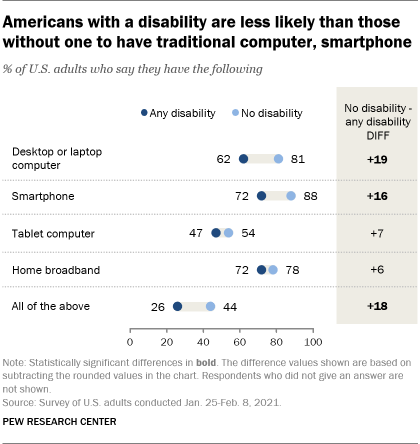
Americans with disabilities and Americans without disabilities are roughly equal in percentage to say they have high-speed internet at home. Yet, Americans with disabilities are less likely than Americans without disabilities to say they use the internet every day (75% vs. 87%) and are three times more likely to say they never go online (15% vs. 5%).
According to data from the National Center for Education Statistics, the percentage of students receiving special education or related services in U.S. public schools has increased over the past decade. In the 2021-22 school year, 7.3 million students in U.S. public schools received special education or related services, making up 15% of all students. This figure is up from the 2010-11 school year, when 6.4 million students with disabilities made up 13% of public school students.
The percentage of students with disabilities in public schools varied across states in the 2021-22 school year, ranging from about 20% in New York, Pennsylvania, and Maine to about 12% in Idaho and Texas. These disparities are likely the result of inconsistencies in how states determine which students qualify for special education services, as well as some of the challenges that come with diagnosing a child’s disability.
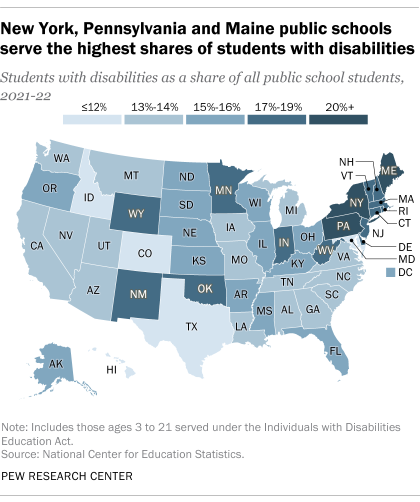
A center analysis conducted in winter 2022 looked at survey responses over time among the same Americans and found that Americans with disabilities are much more likely to experience mental distress during the COVID-19 pandemic than other Americans.
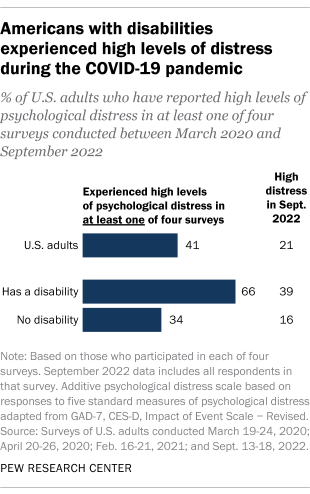
Across four surveys conducted between March 2020 and September 2022, nearly two-thirds (66%) of adults with a disability or health condition that prevents them from fully participating in work, school, household chores or other activities reported feeling high stress at least once, compared with 34% of people without a disability.
U.S. workers generally consider their workplaces accessible to people with disabilities. A February Center survey found that among those who don’t work fully remotely, 76% said their workplace is at least somewhat accessible to people with disabilities, including 51% who said it is very accessible or extremely accessible. Another 17% said their workplace is not very accessible or not at all accessible, and 8% said they weren’t sure.
Whether their workplace is accessible or not, half of workers say the physical accessibility of the workplace is very important to them. Workers with disabilities are roughly the same as workers without disabilities are likely to say so. (Workers are defined as people who work for a business or organization of 10 or more people, not self-employed.)
Note: This is an updated version of a post originally published on July 27, 2017.

